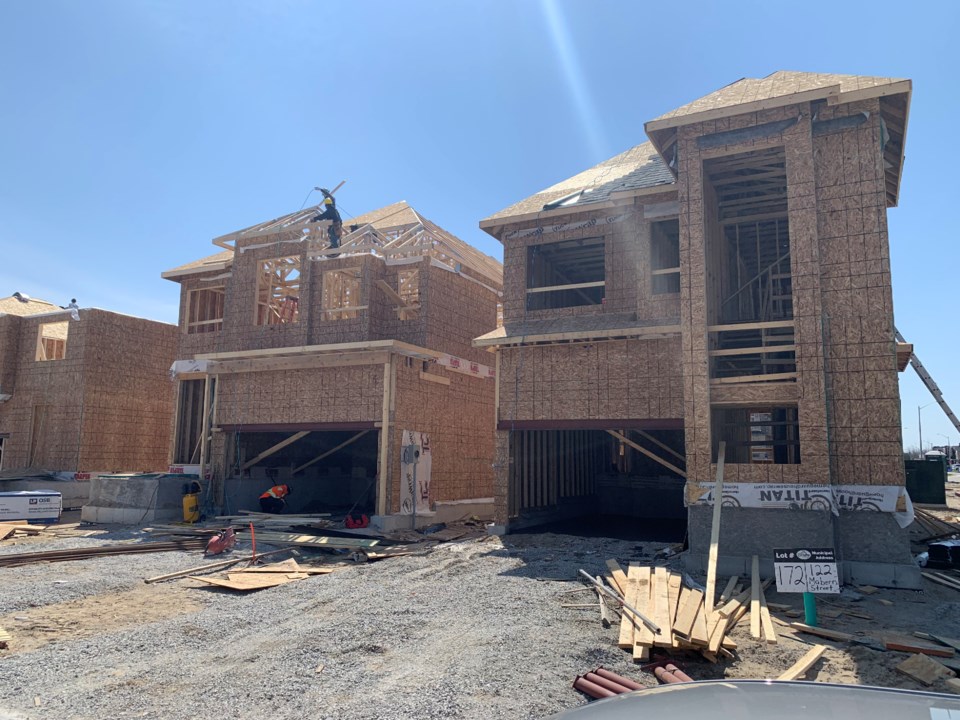Municipal leaders will ask province ‘tough questions’ about housing

Homes under construction in south-end Barrie. Raymond Bowe/BarrieToday
From BarrieToday, August 9, 2023
By Bob Bruton
The County of Simcoe has another ally at this year’s Association of Municipalities of Ontario (AMO) conference, its council heard Tuesday.
Kate Burns Gallagher, executive director of the Western Ontario Wardens Caucus (WOWC), told county councillors it will be asking provincial officials some tough questions about housing at the annual AMO conference in London, Ontario, Aug. 20-23.
“We are going to the province to ask very specifically about their promise to make municipalities whole, and keeping municipalities whole,” she said of financing provincial housing targets.
“We need to make sure those dollars are there,” Burns Gallagher said. “So we’re going to be keeping the feet to the fire of the province on that promise.”
Keeping municipalities whole is supposed to mean that local property tax dollars don’t subsidize provincial initiatives.
Earlier this year, for example, Barrie city council endorsed a pledge with a target of 23,000 new homes built by 2031, in addition to what’s already planned, a requirement of Bill 23, the province’s More Homes Built Faster Act of 2022, which calls for 1.5 million new homes built in Ontario by 2031.
But Barrie councillors had concerns about financing the infrastructure – the roads, pipes, etc. – necessary for new homes. Bill 23 significantly reduces the development charges and parkland levies available to the city for the construction of this infrastructure
Barrie council passed a direct motion in late 2022 to request the province fund the $250-million expansion of the city’s wastewater treatment facility, to aid Barrie in meeting the housing targets outlined by the Ontario government in the More Homes Built Faster Act, 2022.
Now WOWC is going to bat for its members – 15 counties, including Simcoe County, 90 per cent of them rural, representing 300 communities in the region and 1.5 million people.
“We know that infrastructure and affordable housing that is built through our municipalities is a huge asset to our communities and the affordable, attainable housing landscape,” Burns Gallagher said. “We want to know what their (the province’s) definition of keeping municipalities whole means.”
She noted there continue to be inconsistencies in housing development.
“We know there are an extensive number of existing plans of subdivision that are approved…that are not being acted upon (built)” Burns Gallagher said. “We could really make up a lot of ground if those that have been approved were actually starting to be built. There’s a lot of inventory available.”
One of the larger concerns about Ontario’s new housing laws are their effect on development charges – designed to recover the capital costs associated with residential, commercial, industrial, and institutional growth within a municipality from developers so that existing residents don’t have to foot the bill.
But Bill 23 would, for example, exempt development charges for the creation of affordable residential units and attainable residential units, for non-profit housing developments and for inclusionary zoning residential units — a land-use planning policy tool to create mixed-income developments in areas where the market hasn’t provided for a mix of housing prices and rents on its own.
The method for determining development charges is being changed to remove the costs of certain studies from the list of capital costs considered in determining a development charge that may be imposed, and to require development charges to be reduced from what could otherwise be imposed during the first four years a bylaw is in force.
Read the article here









Leave a Reply